
by: Charleeda Sprinkle, Assistant Editor
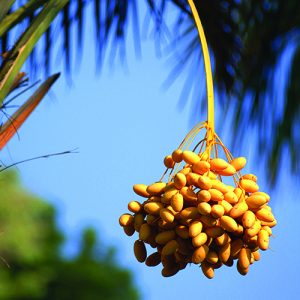
Dates (Photo credit: www.israelimages.com)
The Bible describes the land of Israel in humble terms as a land of only seven species (Deut. 8:8): two grains and five fruits. However, despite being a land that is half desert, modern Israel produces 95% of its own food needs, has become a major exporter of fresh produce (especially citrus), and is a world leader in agricultural technologies. Though Israel produces over 40 types of fruit and groves abound, especially in the North, one can’t describe what the Land looks like without mentioning its vineyards and grey-green olive groves.
It’s not because the country produces so much of either fruit (they don’t), but no doubt because these fruits are so prominent in the life and culture of ancient Israel and are mentioned often in the Bible. The three pilgrim feasts, when all men were required to come up to Jerusalem, were all tied to a harvest, and the first fruits were presented before the Lord in the Temple: barley at Passover (March/April), wheat at Pentecost (usually in June), and fruits at the Feast of Tabernacles (Sept/Oct), though they could be offered as late as Hanukkah in December.
The harvest of the five biblical fruits (grapes, figs, pomegranates, olives, and dates) range from June to November with grapes being the earliest and olives being the latest, although it’s possible to harvest all five fruits (some early, some late) during September. I’ve always wanted to participate in a grape or olive harvest, hoping to glean more understanding of the fruits’ spiritual significance in the Bible, but never had the opportunity.
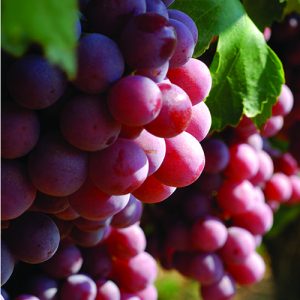
Grapes (Photo credit: Uzi Tzur/www.israelimages.com)
However, volunteer opportunities are available on moshavim and kibbutzim (cooperative communities). For Christians, such opportunities actually fulfill Isaiah 61:5, “Strangers shall stand and feed your flocks, and the sons of the foreigner shall be your plowmen and your vinedressers.” Young families come and work in fields with babies strapped to mothers’ backs and toddlers in tow.
Some volunteers have even worked in the Jewish settlements of Judea and Samaria (known today as the West Bank). Because vineyards in this area have been sabotaged by Arabs at times, owners are cautious in hiring them, and many Jewish people don’t want to take the risk, so foreign volunteer help is a blessing, say vineyard owners. Grapes ripen very fast, so if there are not enough workers, much is lost.
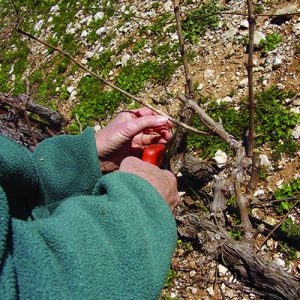
Pruning (Photo credit: DKirchhevel/www.bridgesforpeace.com)
One volunteer said that harvesting grapes is not such hard work, but it is hot work, mostly done during the summer months. Her crew was usually up by 3:00 to 4:00 am in order to arrive at the vineyards by sunrise. Everyone is given a clipper for snipping clusters of grapes from the vine. As much as five tons are picked in a single day. But this is the slow, traditional way; today, most of the grape harvest is done mechanically.
Israel’s wine industry is minuscule in relation to the rest of the world—one California vineyard in the US produces more than all of Israel’s, and 35 countries produce more than Israel. Only in the last decade has Israel begun to campaign their product. They have had to fight political prejudice as well as the fact that most of the world thinks of Israel as a land of desert and camels, not grapes.
Though it’s a relatively new industry in modern-day Israel, its origins are ancient. Hundreds of wine presses have been uncovered in archaeological sites throughout Israel, proof that it was a popular industry. In Roman times, wine from Israel was exported to Rome, but when Israel came under Islamic rule in the seventh century, all vineyards were uprooted.
It wasn’t until the 1880s, when Baron Rothschild established the first winery, that the industry was reestablished. Today, Israel has five regions of vineyards, and in the past 20 years, 20 wineries have grown to 200, which also produce excellent grape juice.
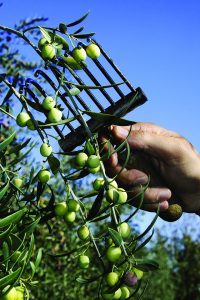
Olive harvesting (Photo credit: www.shutterstock.com)
A symbol of peace and prosperity, the hardy olive tree is found everywhere, not just in private groves. At harvest time, it’s common to see Arab women especially picking olives from trees planted in public parks and on medians in the streets. For Arabs in the Land, olives are an indispensible element of livelihood with up to 40% of the cultivated area of the West Bank and Gaza used for olive groves.
According to Dr. Shaul Eger, an Israeli physiologist, 30 years ago, olive oil was hard to find except in Arab neighborhoods. When olive oil cured him of an “incurable” heart condition, he left his job and planted 1,000 olive trees. Today, he runs a business that produces a variety of olive oil health products, and olive oil now is also a Jewish industry, though Israel, as a nation, only supplies one percent of the world’s olive oil.
Green olives are the most immature, reddish-purple are more mature, and black are fully mature. All of them are pickled and found in a myriad of colors and flavors in Jerusalem’s open-air market. The easiest method of dislodging the fruit from its bough is to shake either the branch or the whole tree. However, some climb a ladder and “milk” them into a sack tied to the waist. An electronic method is used for olives that are crushed for oil, but table olives need to be picked by hand, so they are not bruised. Per year, the average tree yields 1.5 to 2.2 kilograms (3.3 to 4.9 pounds) of oil—even from 2,000-year-old trees!
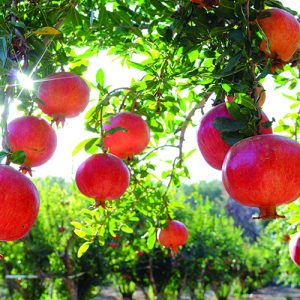
Pomegranates (Photo credit: Uzi Tzur/ www.israelimages.com)
Whether it’s pomegranates hanging heavily from the neighbor’s fence, over-ripe figs falling to the sidewalk, golden dates dangling beneath green palm fronds, clusters of grapes gracing an arbor, or olive trees shimmering in the breeze—all are a testimony to the fruitfulness God promised when His people are dwelling in the Land.
All logos and trademarks in this site are property of their respective owner. All other materials are property of Bridges for Peace. Copyright © 2025.
Website Site Design by J-Town Internet Services Ltd. - Based in Jerusalem and Serving the World.